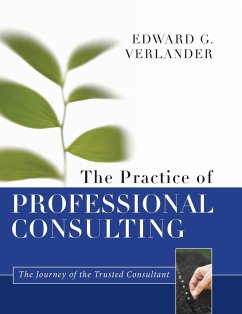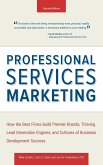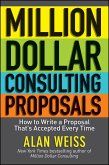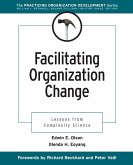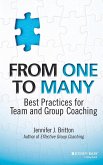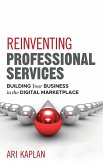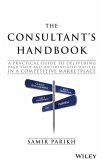Edward G. Verlander
The Practice of Professional C
Edward G. Verlander
The Practice of Professional C
- Gebundenes Buch
- Merkliste
- Auf die Merkliste
- Bewerten Bewerten
- Teilen
- Produkt teilen
- Produkterinnerung
- Produkterinnerung
Despite the size of the consulting industry and its attractiveness to business school graduates, there is a dearth of agreement about what constitutes "professionalism" in consulting. The Practice of Professional Consulting provides the most comprehensive introduction to the field of consulting, including a complete system of guidelines, and all the tools, templates, techniques, case studies, competencies, and assessments to become a professional consultant. Broad enough to be useful to anyone starting any kind of consulting business, yet specific in explaining typical client situations, this…mehr
Andere Kunden interessierten sich auch für
![Professional Services Marketing Professional Services Marketing]() Mike SchultzProfessional Services Marketing27,99 €
Mike SchultzProfessional Services Marketing27,99 €![Winning the Professional Services Sale Winning the Professional Services Sale]() Michael W. McLaughlinWinning the Professional Services Sale30,99 €
Michael W. McLaughlinWinning the Professional Services Sale30,99 €![Million Dollar Consulting Proposals Million Dollar Consulting Proposals]() Alan WeissMillion Dollar Consulting Proposals24,99 €
Alan WeissMillion Dollar Consulting Proposals24,99 €![Facilitating Organization Change Facilitating Organization Change]() Edwin E. OlsonFacilitating Organization Change71,99 €
Edwin E. OlsonFacilitating Organization Change71,99 €![From One to Many From One to Many]() Jennifer J. BrittonFrom One to Many44,99 €
Jennifer J. BrittonFrom One to Many44,99 €![Reinventing Professional Services Reinventing Professional Services]() Ari KaplanReinventing Professional Services31,99 €
Ari KaplanReinventing Professional Services31,99 €![The Consultant's Handbook The Consultant's Handbook]() Samir ParikhThe Consultant's Handbook31,99 €
Samir ParikhThe Consultant's Handbook31,99 €-
-
-
Despite the size of the consulting industry and its attractiveness to business school graduates, there is a dearth of agreement about what constitutes "professionalism" in consulting. The Practice of Professional Consulting provides the most comprehensive introduction to the field of consulting, including a complete system of guidelines, and all the tools, templates, techniques, case studies, competencies, and assessments to become a professional consultant. Broad enough to be useful to anyone starting any kind of consulting business, yet specific in explaining typical client situations, this guide offers new and aspiring consultants with a perspective of the rules, roles, values, methods, and techniques used across firms in the consulting industry.
Hinweis: Dieser Artikel kann nur an eine deutsche Lieferadresse ausgeliefert werden.
Hinweis: Dieser Artikel kann nur an eine deutsche Lieferadresse ausgeliefert werden.
Produktdetails
- Produktdetails
- Verlag: Wiley & Sons
- 1. Auflage
- Seitenzahl: 320
- Erscheinungstermin: 30. Oktober 2012
- Englisch
- Abmessung: 241mm x 196mm x 22mm
- Gewicht: 680g
- ISBN-13: 9781118241844
- ISBN-10: 1118241843
- Artikelnr.: 34450230
- Herstellerkennzeichnung
- Libri GmbH
- Europaallee 1
- 36244 Bad Hersfeld
- gpsr@libri.de
- Verlag: Wiley & Sons
- 1. Auflage
- Seitenzahl: 320
- Erscheinungstermin: 30. Oktober 2012
- Englisch
- Abmessung: 241mm x 196mm x 22mm
- Gewicht: 680g
- ISBN-13: 9781118241844
- ISBN-10: 1118241843
- Artikelnr.: 34450230
- Herstellerkennzeichnung
- Libri GmbH
- Europaallee 1
- 36244 Bad Hersfeld
- gpsr@libri.de
THE AUTHOR Edward Verlander is chairman of Verlander, Wang & Co., LLC, an international management consulting firm that delivers services in strategy, organization change, leadership development, and executive coaching. Clients are world-wide and embrace the Fortune 500, numerous European technology companies and, most recently, the public and private education sectors in China. He also teaches MBA-level business consulting at Long Island University and has taught management at Columbia and Hofstra Universities, as well as in the business schools at Jilin University and Nanjing University in China.
About This Book xii
Preface xv
Acknowledgments xviii
Part One: Setting the Stage 1
1 The Nature of Consulting 3
It's an Industry 4
Types of Consulting 8
Scope of Consulting 10
Trusted Consultant and Advisor 12
Consultant Qualifications 14
What Is Professional Consulting? 16
2 Why Companies Hire Consultants 19
Why Consultants Are Needed 19
Fast, Bigger, Better, Cheaper Outcomes 21
Forces That Drive Business Consulting 25
Expectations of Consultant Services 30
Changes in Client's Business and Organization Needs 31
Future Challenges 34
3 A Model for Professional Consulting 38
What Do We Mean by "Process"? 38
A Framework for Consulting 39
The Four Stages of Consulting 44
The Four Roles of Consulting 46
Consulting Competencies 48
Part Two: Applying the Model 53
4 Stage One: The Developing and Designing Process 55
Stage One Competencies: Winning the Business 56
Understanding the Client's Business and Industry 59
Making a Good First Impression 61
First Meeting Dynamics 63
5 Stage One, Continued: Assessing Client Needs and Managing Expectations 70
The Purpose of Conducting a Needs Assessment 70
Types of Questions: The Fundamentals 72
Conducting a Needs Assessment: A Question Strategy 74
Needs Assessment: Listening Actively 79
The Proposal Development Process 82
Managing Expectations 91
6 Stage Two: The Mobilizing and Aligning Process 96
Stage Two Competencies: Mobilizing and Aligning 96
Work and Project Plan Reviews 97
Risk Assessment Factors 106
Project Launch Meetings 108
7 Stage Two, Continued: Turning a Consulting Group into a Team 116
Defining a Team 116
Stages of Team Development 119
Diagnosing Project Team Performance 121
How Team Building Is Conducted 122
Special Problems in Building Project Teams 123
Characteristics of High-Performing Teams 126
The Project Leader Style Needed for Team Building 127
8 Stage Three: The Building and Producing Process 130
Stage Three Competencies: Building and Producing 131
Data Gathering 132
Performance Management and Coaching 137
Coaching Consultants 139
Motivating Consultants 146
Progress Review Meetings 151
Navigating Organizational Politics 155
Project Management Issues 161
9 Stage Four: The Implementing and Deploying Process 168
Stage Four Competencies: Implementing and Deploying 169
Managing Change 171
Implementation Strategies 175
Skills Transfer 180
Measuring Customer Satisfaction 186
Satisfaction Assessment Metrics 190
Part Three: The Bigger Picture 195
10 Improving Consulting as a Professional Practice 197
A Reality Check About Consulting 198
The Need to Professionalize Consulting 200
Professional Capabilities of Consultants 205
Building Block One: Client's Business Focus 208
Building Block Two: Business Management 210
Building Block Three: Technical Requirements 214
Building Block Four: Interpersonal Attributes 215
Building Block Five: Effective Leadership 217
11 Lessons of Experience 222
How to Grow in Professional Capability 223
Lessons from McKinsey 225
The Pain and Joy of a Consulting Career 227
Professional Proficiencies in Consulting 231
Trends for the Twenty-First Century 234
Appendices
A The Consulting Role Preference Indicator 238
B Guidelines for Successful Consulting 250
C The Leadership Role of Consultants 258
D Consulting Case Applications 262
E Diagnostic Procedures and Instruments for Consulting Teams 264
Bibliography and Resources 274
About the Author 280
Index 282
Preface xv
Acknowledgments xviii
Part One: Setting the Stage 1
1 The Nature of Consulting 3
It's an Industry 4
Types of Consulting 8
Scope of Consulting 10
Trusted Consultant and Advisor 12
Consultant Qualifications 14
What Is Professional Consulting? 16
2 Why Companies Hire Consultants 19
Why Consultants Are Needed 19
Fast, Bigger, Better, Cheaper Outcomes 21
Forces That Drive Business Consulting 25
Expectations of Consultant Services 30
Changes in Client's Business and Organization Needs 31
Future Challenges 34
3 A Model for Professional Consulting 38
What Do We Mean by "Process"? 38
A Framework for Consulting 39
The Four Stages of Consulting 44
The Four Roles of Consulting 46
Consulting Competencies 48
Part Two: Applying the Model 53
4 Stage One: The Developing and Designing Process 55
Stage One Competencies: Winning the Business 56
Understanding the Client's Business and Industry 59
Making a Good First Impression 61
First Meeting Dynamics 63
5 Stage One, Continued: Assessing Client Needs and Managing Expectations 70
The Purpose of Conducting a Needs Assessment 70
Types of Questions: The Fundamentals 72
Conducting a Needs Assessment: A Question Strategy 74
Needs Assessment: Listening Actively 79
The Proposal Development Process 82
Managing Expectations 91
6 Stage Two: The Mobilizing and Aligning Process 96
Stage Two Competencies: Mobilizing and Aligning 96
Work and Project Plan Reviews 97
Risk Assessment Factors 106
Project Launch Meetings 108
7 Stage Two, Continued: Turning a Consulting Group into a Team 116
Defining a Team 116
Stages of Team Development 119
Diagnosing Project Team Performance 121
How Team Building Is Conducted 122
Special Problems in Building Project Teams 123
Characteristics of High-Performing Teams 126
The Project Leader Style Needed for Team Building 127
8 Stage Three: The Building and Producing Process 130
Stage Three Competencies: Building and Producing 131
Data Gathering 132
Performance Management and Coaching 137
Coaching Consultants 139
Motivating Consultants 146
Progress Review Meetings 151
Navigating Organizational Politics 155
Project Management Issues 161
9 Stage Four: The Implementing and Deploying Process 168
Stage Four Competencies: Implementing and Deploying 169
Managing Change 171
Implementation Strategies 175
Skills Transfer 180
Measuring Customer Satisfaction 186
Satisfaction Assessment Metrics 190
Part Three: The Bigger Picture 195
10 Improving Consulting as a Professional Practice 197
A Reality Check About Consulting 198
The Need to Professionalize Consulting 200
Professional Capabilities of Consultants 205
Building Block One: Client's Business Focus 208
Building Block Two: Business Management 210
Building Block Three: Technical Requirements 214
Building Block Four: Interpersonal Attributes 215
Building Block Five: Effective Leadership 217
11 Lessons of Experience 222
How to Grow in Professional Capability 223
Lessons from McKinsey 225
The Pain and Joy of a Consulting Career 227
Professional Proficiencies in Consulting 231
Trends for the Twenty-First Century 234
Appendices
A The Consulting Role Preference Indicator 238
B Guidelines for Successful Consulting 250
C The Leadership Role of Consultants 258
D Consulting Case Applications 262
E Diagnostic Procedures and Instruments for Consulting Teams 264
Bibliography and Resources 274
About the Author 280
Index 282
About This Book xii
Preface xv
Acknowledgments xviii
Part One: Setting the Stage 1
1 The Nature of Consulting 3
It's an Industry 4
Types of Consulting 8
Scope of Consulting 10
Trusted Consultant and Advisor 12
Consultant Qualifications 14
What Is Professional Consulting? 16
2 Why Companies Hire Consultants 19
Why Consultants Are Needed 19
Fast, Bigger, Better, Cheaper Outcomes 21
Forces That Drive Business Consulting 25
Expectations of Consultant Services 30
Changes in Client's Business and Organization Needs 31
Future Challenges 34
3 A Model for Professional Consulting 38
What Do We Mean by "Process"? 38
A Framework for Consulting 39
The Four Stages of Consulting 44
The Four Roles of Consulting 46
Consulting Competencies 48
Part Two: Applying the Model 53
4 Stage One: The Developing and Designing Process 55
Stage One Competencies: Winning the Business 56
Understanding the Client's Business and Industry 59
Making a Good First Impression 61
First Meeting Dynamics 63
5 Stage One, Continued: Assessing Client Needs and Managing Expectations 70
The Purpose of Conducting a Needs Assessment 70
Types of Questions: The Fundamentals 72
Conducting a Needs Assessment: A Question Strategy 74
Needs Assessment: Listening Actively 79
The Proposal Development Process 82
Managing Expectations 91
6 Stage Two: The Mobilizing and Aligning Process 96
Stage Two Competencies: Mobilizing and Aligning 96
Work and Project Plan Reviews 97
Risk Assessment Factors 106
Project Launch Meetings 108
7 Stage Two, Continued: Turning a Consulting Group into a Team 116
Defining a Team 116
Stages of Team Development 119
Diagnosing Project Team Performance 121
How Team Building Is Conducted 122
Special Problems in Building Project Teams 123
Characteristics of High-Performing Teams 126
The Project Leader Style Needed for Team Building 127
8 Stage Three: The Building and Producing Process 130
Stage Three Competencies: Building and Producing 131
Data Gathering 132
Performance Management and Coaching 137
Coaching Consultants 139
Motivating Consultants 146
Progress Review Meetings 151
Navigating Organizational Politics 155
Project Management Issues 161
9 Stage Four: The Implementing and Deploying Process 168
Stage Four Competencies: Implementing and Deploying 169
Managing Change 171
Implementation Strategies 175
Skills Transfer 180
Measuring Customer Satisfaction 186
Satisfaction Assessment Metrics 190
Part Three: The Bigger Picture 195
10 Improving Consulting as a Professional Practice 197
A Reality Check About Consulting 198
The Need to Professionalize Consulting 200
Professional Capabilities of Consultants 205
Building Block One: Client's Business Focus 208
Building Block Two: Business Management 210
Building Block Three: Technical Requirements 214
Building Block Four: Interpersonal Attributes 215
Building Block Five: Effective Leadership 217
11 Lessons of Experience 222
How to Grow in Professional Capability 223
Lessons from McKinsey 225
The Pain and Joy of a Consulting Career 227
Professional Proficiencies in Consulting 231
Trends for the Twenty-First Century 234
Appendices
A The Consulting Role Preference Indicator 238
B Guidelines for Successful Consulting 250
C The Leadership Role of Consultants 258
D Consulting Case Applications 262
E Diagnostic Procedures and Instruments for Consulting Teams 264
Bibliography and Resources 274
About the Author 280
Index 282
Preface xv
Acknowledgments xviii
Part One: Setting the Stage 1
1 The Nature of Consulting 3
It's an Industry 4
Types of Consulting 8
Scope of Consulting 10
Trusted Consultant and Advisor 12
Consultant Qualifications 14
What Is Professional Consulting? 16
2 Why Companies Hire Consultants 19
Why Consultants Are Needed 19
Fast, Bigger, Better, Cheaper Outcomes 21
Forces That Drive Business Consulting 25
Expectations of Consultant Services 30
Changes in Client's Business and Organization Needs 31
Future Challenges 34
3 A Model for Professional Consulting 38
What Do We Mean by "Process"? 38
A Framework for Consulting 39
The Four Stages of Consulting 44
The Four Roles of Consulting 46
Consulting Competencies 48
Part Two: Applying the Model 53
4 Stage One: The Developing and Designing Process 55
Stage One Competencies: Winning the Business 56
Understanding the Client's Business and Industry 59
Making a Good First Impression 61
First Meeting Dynamics 63
5 Stage One, Continued: Assessing Client Needs and Managing Expectations 70
The Purpose of Conducting a Needs Assessment 70
Types of Questions: The Fundamentals 72
Conducting a Needs Assessment: A Question Strategy 74
Needs Assessment: Listening Actively 79
The Proposal Development Process 82
Managing Expectations 91
6 Stage Two: The Mobilizing and Aligning Process 96
Stage Two Competencies: Mobilizing and Aligning 96
Work and Project Plan Reviews 97
Risk Assessment Factors 106
Project Launch Meetings 108
7 Stage Two, Continued: Turning a Consulting Group into a Team 116
Defining a Team 116
Stages of Team Development 119
Diagnosing Project Team Performance 121
How Team Building Is Conducted 122
Special Problems in Building Project Teams 123
Characteristics of High-Performing Teams 126
The Project Leader Style Needed for Team Building 127
8 Stage Three: The Building and Producing Process 130
Stage Three Competencies: Building and Producing 131
Data Gathering 132
Performance Management and Coaching 137
Coaching Consultants 139
Motivating Consultants 146
Progress Review Meetings 151
Navigating Organizational Politics 155
Project Management Issues 161
9 Stage Four: The Implementing and Deploying Process 168
Stage Four Competencies: Implementing and Deploying 169
Managing Change 171
Implementation Strategies 175
Skills Transfer 180
Measuring Customer Satisfaction 186
Satisfaction Assessment Metrics 190
Part Three: The Bigger Picture 195
10 Improving Consulting as a Professional Practice 197
A Reality Check About Consulting 198
The Need to Professionalize Consulting 200
Professional Capabilities of Consultants 205
Building Block One: Client's Business Focus 208
Building Block Two: Business Management 210
Building Block Three: Technical Requirements 214
Building Block Four: Interpersonal Attributes 215
Building Block Five: Effective Leadership 217
11 Lessons of Experience 222
How to Grow in Professional Capability 223
Lessons from McKinsey 225
The Pain and Joy of a Consulting Career 227
Professional Proficiencies in Consulting 231
Trends for the Twenty-First Century 234
Appendices
A The Consulting Role Preference Indicator 238
B Guidelines for Successful Consulting 250
C The Leadership Role of Consultants 258
D Consulting Case Applications 262
E Diagnostic Procedures and Instruments for Consulting Teams 264
Bibliography and Resources 274
About the Author 280
Index 282

